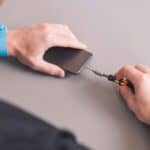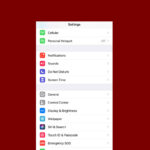iMessage is Apple’s messaging service that lets users send texts, photos, videos, and more using Wi-Fi or cellular data. It offers end-to-end encryption, which means that only the sender and receiver can read the messages. However, there are some situations where someone could access your iMessages. If you’re worried about the privacy of your iMessages, you’re not alone. With more people using digital communication, it’s normal to wonder who might see your private chats. This article looks at iMessage security and how someone could read your messages without your permission. It also gives tips on how to protect your iMessages and keep your conversations private.
Protecting Your iMessages: Who Can See Your Conversations?
Understanding iMessage Security
iMessage is designed with privacy in mind. It uses end-to-end encryption, meaning your messages are scrambled so only you and the recipient can read them. Apple can’t even see your iMessages.
Ways Someone Could Access Your iMessages
- Physical Access to Your Device: If someone has physical access to your unlocked iPhone, iPad, or Mac, they can easily read your iMessages.
- iCloud Backup: If you have iCloud backup enabled, your iMessages are backed up to your iCloud account. If someone gains access to your iCloud credentials, they could potentially access your messages through the backup.
- Apple ID Password: Anyone who knows your Apple ID password can access your iMessages by logging into your account on another device.
- Jailbreaking: Jailbreaking your iPhone removes Apple’s security restrictions, making it more vulnerable to malware and hacking attempts that could compromise your iMessages.
- Law Enforcement: In certain situations, law enforcement agencies may be able to obtain a warrant to access your iMessages stored on Apple’s servers or iCloud backups.
Protecting Your iMessages
- Strong Passcode: Use a strong and unique passcode to prevent unauthorized access to your device.
- Face ID/Touch ID: Enable Face ID or Touch ID for an additional layer of security.
- Two-Factor Authentication: Enable two-factor authentication for your Apple ID to prevent unauthorized logins.
- Regular Software Updates: Keep your devices updated with the latest software to benefit from the latest security patches.
- Beware of Phishing: Be cautious of phishing attempts that try to trick you into revealing your Apple ID password or other sensitive information.
- Limit iCloud Backup: Consider disabling iCloud backup for iMessages or use a strong password for your iCloud account.
| Security Measure | Description |
|---|---|
| Strong Passcode | Prevents unauthorized device access |
| Face ID/Touch ID | Adds an extra layer of security |
| Two-Factor Authentication | Prevents unauthorized Apple ID logins |
| Software Updates | Ensures you have the latest security patches |
| Phishing Awareness | Avoids revealing sensitive information |
| iCloud Backup Management | Limits access to your iCloud backups |
By taking these precautions, you can significantly reduce the risk of someone accessing your iMessages and keep your conversations private.
Additional Tips for iMessage Security
- Verify Device Trust: When you sign in to iMessage on a new device, make sure it is a trusted device that you own.
- Review Account Activity: Regularly check your Apple ID account activity for any suspicious login attempts.
- Report Suspicious Activity: If you notice any unusual activity on your account, report it to Apple immediately.
Remember, while iMessage offers strong encryption, it’s important to be aware of potential vulnerabilities and take steps to protect your privacy.
Who Might Access Your iMessages?
While iMessage is secure, there are a few situations where someone might be able to see your messages:
| Person or Entity | How They Might Access Your iMessages |
|---|---|
| The Recipient | The person you’re messaging can obviously read your iMessages. They can also choose to share or forward your messages to others. |
| Someone with Your iPhone | If someone has physical access to your unlocked iPhone, they can open the Messages app and read your conversations. |
| Someone with Your Apple ID and Password | If someone knows your Apple ID and password, they could sign in to your iCloud account and access your iMessages if you have iCloud backup turned on. They could also sign in to iMessage on another device with your Apple ID and see your messages. |
| Law Enforcement | In some cases, law enforcement agencies may be able to obtain your iMessages with a warrant. |
| Hackers | While rare, it’s possible for skilled hackers to exploit vulnerabilities in software or devices to gain access to your iMessages. |
How to Protect Your iMessages
- Use a Strong Password: Create a strong password for your Apple ID and enable two-factor authentication for added security.
- Keep Your iPhone Secure: Use a passcode, Face ID, or Touch ID to lock your iPhone and prevent unauthorized access.
- Be Careful Who You Share Your Apple ID With: Only share your Apple ID and password with people you trust.
- Disable iMessage on Old Devices: If you no longer use an old iPhone, iPad, or Mac, make sure to sign out of iMessage to prevent your messages from appearing on that device.
- Keep Your Software Up to Date: Install the latest software updates for your iPhone and other Apple devices to ensure you have the most recent security patches.
IMessage Security and Access
When it comes to iMessage, Apple places a high priority on keeping messages secure. Your texts and attachments are meant for your eyes only, ensuring no unauthorized peeking from outsiders.
Authentication and Apple ID
An Apple ID is your key to all Apple services, including iMessage. To access iMessage, one must sign in with their unique Apple ID and password. This is your first layer of defense against intruders. If someone knows your Apple ID credentials, they could potentially send and receive iMessages as you.
Two-Factor Authentication
For an extra layer of security, Apple offers two-factor authentication (2FA). When 2FA is enabled, even knowing your Apple ID and password isn’t enough; a code is needed from a device you trust. Always review the list of trusted devices within your Apple account settings. If you spot an unfamiliar iPhone or iPad, someone else might have access to your iMessages.
Apple Device Configuration for Imessage
Setting up iMessage properly on your iPhone or iPad is crucial. Under Settings, navigate to ‘Messages’ and make sure ‘Send & Receive’ is configured to use your Apple ID correctly. If you’re a part of a family sharing plan, ensure that your iMessage settings don’t mistakenly grant access to other family members’ devices. Keep an eye on iCloud as well, since your messages might be stored there if you’ve chosen to enable iCloud backups.
Managing iMessage Settings
When setting up iMessage on your Apple devices, it’s important to keep a close eye on your settings to maintain privacy and control how you send and receive messages.
Send & Receive Options
In the Settings app, navigate to Messages and tap Send & Receive. This is where you can select your phone numbers and email addresses that you would like to use with iMessage. You can choose one or many options from the list provided; this list includes the email addresses and phone numbers linked to your Apple ID. Be mindful that any change you make here affects all your Apple devices utilizing the same Apple ID for iMessages.
To prevent others from seeing your messages, check the email addresses and phone numbers listed. If you spot an unfamiliar one, it might be wise to remove it. Regularly checking these settings can also help in the situation where a device you no longer use is still connected to your iMessage account.
Family Sharing and Contacts Integration
Family Sharing allows multiple Apple IDs to share purchases, subscriptions, calendars, and more. It’s also important to see how iMessage integrates with your family members under Family Sharing settings. While Family Sharing is great for keeping everyone connected, you’ll want to ensure that your iMessages remain private and aren’t being mistakenly shared among family members’ devices.
You can manage these settings by going to Settings, then tapping your name, and finally navigating to Family Sharing. Here, review the listed family members and ensure that your contacts are up-to-date. It’s important to confirm that each family member is using their own Apple ID for iMessage. If everyone’s devices and accounts are not properly separated, family members might inadvertently receive messages not intended for them. This happens particularly when devices are logged into a shared or incorrect Apple ID.
Preventing Unauthorized iMessage Access
Ensuring iMessage remains private means staying vigilant against unauthorized access and potential security threats. Here’s how users can keep their conversations secure.
Recognizing and Avoiding iMessage Interception
Privacy is a top concern for iMessage users. To prevent spying, it’s crucial to understand how unauthorized access might occur. Intercepting iMessages typically involves compromising iCloud credentials. Users should never share their login information and should sign out from devices they no longer use. Additionally, consistently watching for unusual activity on their account can hint at someone trying to intercept messages.
- Watch for alerts from Apple about sign-ins on new devices.
- Check connected devices regularly in the iCloud settings and remove any unknown devices.
Protecting Against iMessage Exploits
Security isn’t just about preventing hackers; it also involves safeguarding against spyware and exploits that can compromise messages. Users should active two-factor authentication (2FA) for an extra layer of safety. This means even if a password is compromised, the account stays protected. Updating devices to the latest iOS ensures that any security holes are patched, keeping user data secure from potential exploits.
To enhance security:
- Enable 2FA for iCloud and Apple ID.
- Update devices promptly to patch security vulnerabilities.
By following these steps, users can significantly improve the safety and privacy of their iMessage conversations.
Frequently Asked Questions
When it comes to securing your iMessages, understanding how to monitor and protect your account is essential. These FAQs will walk you through the basics of keeping your iMessages private and secure.
How can I tell if my iMessage is being accessed on another device?
You can check which devices are signed into your account by going to Settings > [your name]. This list will show you all devices currently authorized to receive iMessages sent to your account.
What are the signs that my text messages are being read by someone else on their phone?
Unexpected behavior, such as messages being marked as read when you haven’t seen them or new devices showing up in your device list, might indicate someone else has access to your texts.
What steps can I take to prevent someone from reading my iMessages on another iPhone?
Change your passwords frequently and ensure two-factor authentication is enabled. Regularly review the devices connected to your Apple ID and remove any you don’t recognize.
Is it possible to detect unauthorized access to my iMessage account?
Yes, by checking for unknown devices in your Apple account settings and looking for irregularities in message delivery and read receipts, you can spot unauthorized access.
How can I secure my iMessages to ensure they are not seen from another device?
Make sure to enable two-factor authentication, use a strong password, and regularly monitor the devices connected to your Apple ID. Also, sign out of iMessage on devices you no longer use.
Are there any specific settings to safeguard iMessages against external access?
Yes, you can adjust settings to require a password for purchases, disable message forwarding to other devices, and sign out of iMessage on devices you’re not actively using to prevent external access.





